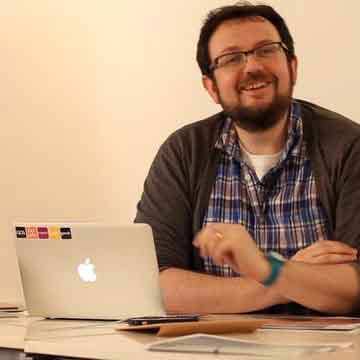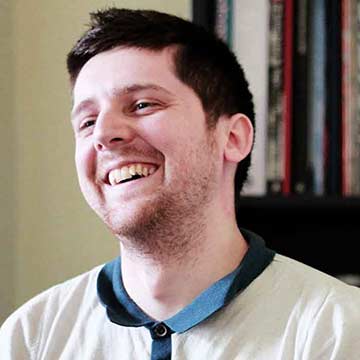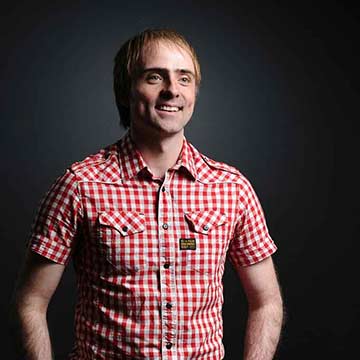Sponsors
During the breaks, our sponsors will have stands in the foyer. Without their generosity (R)evolution wouldn't be possible, so spend some time at their stands.
Download the sponsorship packFriday, 27 September 2013
Shropshire Conference Centre, Shrewsbury
Collect your badge and conference bag, enjoy a chat and a coffee
Kirsty and Zach welcome you to the fourth Shropgeek (R)Evolution

In a former life Chris spent four years studying for a chemistry degree and then another three researching for a PhD in structural and molecular biology. Part way through his PhD in 1992 he set up a website on his desktop machine using the recently released CERN webserver and he's been building websites ever since.
He's been responsible for web projects as diverse as the public consultation and display of sculpture on The Fourth Plinth in Trafalgar Square, a video on demand archive for Nobel Prize Winners, the first ever Open Access science journal and the premiere of a James Bond film. He ran the technology team which built Moshi Monsters and helped to set up The Guardian Open Platform and the Government Digital Service. He is currently the consultant Chief Technology Officer of the Design and Artists Copyright Society.
Recently he's been experimenting with crowdsourcing, crowdfunding, 3D scanning and 3D printing to build up a new venture called The Flexiscale Company which is experimenting in micro/mini manufacturing to make high resolution 3D printed plastic model kits of obscure railway items.

Dafydd is a developer and technical lead at the Government Digital Service (GDS). For the past 18 months he's worked on building the new digital face of government, GOV.UK, and is now working on transforming government transactions.
He has worked with government and charities to make information and data easier to understand, and also helps to open up public datasets and make tools that make it simpler for the public hold companies to account.
A short break for refreshments.

It's not only important to consider what we say to our users, but how we say it. Using plenty of examples from around the web, Rob will talk about tone of voice, what it is, why it's important and how you can find your own.
BIO
Rob Mills is Studio Manager at Bluegg and author of Designing the Invisible from Five Simple Steps. As a journalism graduate and former BBC Audience Researcher he likes words and data but mainly words. He has written for Smashing Magazine, 24Ways and you might also spot him in .Net Magazine as part of their big question panel. This is his fifth web related talk. He will write for coffee or Monster Munch but never for raisins or yoghurts with bits in.

There are two dangerous myths when it comes to accessibility: 1, accessibility only affects a few users. 2, accessibility is something which is applied during development.
This talk will include guidelines for top accessible design considerations, examples of the mistakes designers make again and again, and tips to take away and use in your next project, making your interfaces a better, and more inclusive, experience.
BIO
Laura Kalbag is a designer easily excited by web design and development. Among her list of ever-changing pet subjects are responsive web, semantic web, and web fonts, but she's really fascinated by anything in the areas of web, mobile and design.
Laura has been a freelancer for the whole of her professional life. She revels in working with small and meaningful clients, creating websites, apps, icons, illustrations and the odd logo.
A special session during the day that allows the audience the chance to gain answers to those really important questions (relevant to their specialism, of course!). No one expects them to know the answer to the meaning of life.
Sandwiches and refreshments

CSS is easy? CSS is messy! And as a project grows, it only gets messier. You find yourself throwing !important at everything or fighting with long selectors just to get a style to overrule another. This session looks at a few quick tips to help bring things under control.
BIO
Jonathan Snook writes about tips, tricks and bookmarks on his blog. He has also written for A List Apart, 24ways, and .net magazine, and he has co-authored two books, The Art and Science of CSS and Accelerated DOM Scripting. Most recently, Snook has written the eBook SMACSS, sharing his experience and best practices on CSS architecture. Jonathan also works on the design team at Shopify.

As an application matures and features get added it can be difficult to keep your code readable, scaleable and easy to work with. Things can get very ugly very quickly. Using TweetDeck as a working example, we look at how the Flight JavaScript framework and a sensible approach to markup & CSS can really make a difference.
BIO
James is a front-end software engineer at Twitter, formerly UI & UX architect at TweetDeck and has worked with a variety of front-end technologies for many years. He has developed interactive projects for the likes of Egg Bank, Prudential and Nokia. James has presented at user groups, conferences and written for magazines on design and development.
A short break for refreshments

Joel will be talking about some of the harsh lessons he's had to learn since working for himself. Being your own boss is a liberating experience but it can also feel like a trap; tune to see if Joel can spare you some heartache.
BIO
Joel is a website producer who has been in the game for a long old time; he was wrestling with IE3 (yes 3!) and table based layouts whilst many of the current generation of coders were still on the potty. Whilst this means he is old & decrepit, it does also mean that he has lots of experience which he’s more than willing to share.
Joel has been in permanent roles (American Express, British Airways), has contracted & has now been working for himself, and managing a remote team, for over 12 years.
As well as all of this he runs the Port80 web conference in South Wales, is married to Jess, has two children (Lily & Gene) and one cat (Mr Pickles).

Flash turned the web from a bland mess into a rich, interactive playground. Web Standards brought the web a much-needed sense of unity, clarity, and accessibility. Web fonts gave the web print-level typographic control. Responsive Web Design returned the web to its roots as an inherently fluid medium. All of these revolutions in design and development, and all in such a short period of time!
Elliot has not had an online portfolio in over five years. In assembling a new portfolio for September 2013 and attempting to collate over ten years' worth of work, he's accidentally documented the evolution of the web design industry: its highs, its lows... even its pixel fonts.
In this deeply personal talk, Elliot uses the process of creating his new portfolio — and highlighting the ground-breaking work of other designers and developers — to examine where we are now and from where we have come. And perhaps most importantly: where next?
BIO
Elliot Jay Stocks is Creative Director of Adobe Typekit, founder of typography magazine 8 Faces, and co-founder of Viewport Industries.
His work can often be seen in books, blogs, and magazines, with a portfolio containing clients such as Virgin, Microsoft, Brooklyn Beta, Smashing Magazine, and MailChimp. He gives talks at events including An Event Apart, TYPO Berlin, South by Southwest, and Web Directions, and writes for publications such as Codex: The Journal of Typography, .Net, and Computer Arts. He lives and works in the countryside between Bristol and Bath, England, with his wife and their dog.
Kirsty and Zach wrap up the day